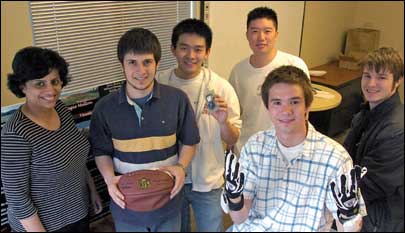Priya Narasimhan is a football fanatic who hates to see referees make bad calls during a game. She’s also an associate professor of electrical and computer engineering at Carnegie Mellon University. So she combined these two passions, recruited several like-minded students, and created a system that leverages sensor, ZigBee and GPS technologies to monitor football plays. “I got the idea about two years ago,” Narasimhan says. “I was watching a [Pittsburgh] Steelers game, and it was one of those games where you end up throwing things at the TV because of the referee calls.”
Narasimhan and her team infused a web of conductive thread with tiny pressure sensors into a pair of standard-issue gloves, to measure how a wide receiver grips the ball. The thread—basically, a very flexible metal that can conduct electric pulses—terminates at the wrist of the glove, where there’s a ZigBee transmitter that communicates with ZigBee base stations positioned off the field.
The team developed software that analyzes the data captured from the gloves and displays it as an animation of two hands and circles that represent each of the sensors. “The circles, or dots, on the animation will get bigger if a sensor is fired in a big way,” Narasimhan says. “So you can visually see and know exactly where [the player] put the most pressure when catching the football.”
The monitoring system also includes a football rigged with an accelerometer to measure speed, and a mini-GPS to capture the ball’s position on the field. “Right now, the GPS isn’t ideal; it gets position to feet, not the inches that I want,” Narasimhan says. “But we are working on a new prototype to see if a differential GPS with ground-based systems, rather than satellite communications, will give us more accurate, fine-grain locations of where the football is on the field.”
This year, the high-tech team plans to work with the university’s football team to test the system. It could, for example, determine whether the receiver really had control of the ball before stepping out of bounds. In addition to helping refs make better calls, Narasimhan says managers could use the high-tech gloves and ball as a training aid.


